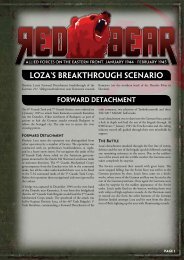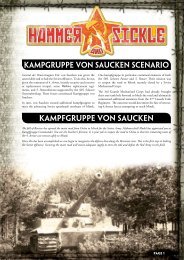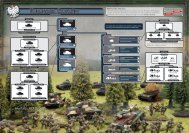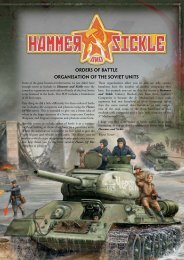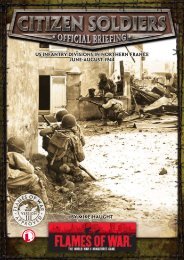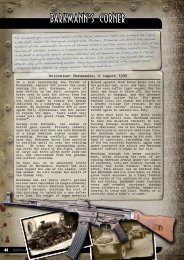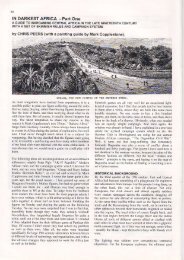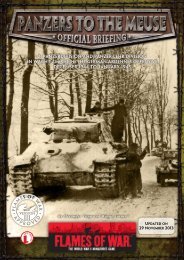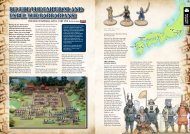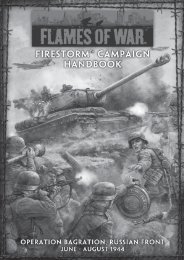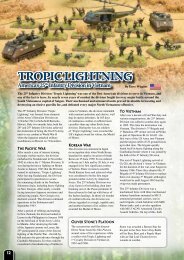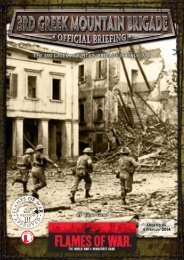Download a PDF version of this article here - Flames of War
Download a PDF version of this article here - Flames of War
Download a PDF version of this article here - Flames of War
You also want an ePaper? Increase the reach of your titles
YUMPU automatically turns print PDFs into web optimized ePapers that Google loves.
The Tropaeum Traiani is a monument built in 109 in then<br />
Moesia Inferior, to commemorate Roman Emperor Trajan’s<br />
victory over the Dacians, in 101, in the Battle <strong>of</strong> Tapae. The<br />
monument was erected on the place w<strong>here</strong> legio XXI Rapax<br />
had previously been crushed (92 AD).<br />
The power centers <strong>of</strong> the Dacian elite<br />
reflected strong relationships with the<br />
great states <strong>of</strong> their day. Most visibly<br />
<strong>this</strong> took shape in the form <strong>of</strong> stonework<br />
citadels and temples, erected in strategic<br />
river valleys and built in Hellenstic<br />
styles. Imported Greek goods and coins<br />
(likely from Black Sea tributary cities)<br />
circulated to these strongholds during<br />
the reign <strong>of</strong> the 1st Century BC Dacian<br />
king Burebista, and noticeable trade<br />
with Rome began around that time as<br />
well. The last half <strong>of</strong> the next century<br />
witnessed an increased influx <strong>of</strong> Roman<br />
coins, tools, and craftsmen, especially<br />
when the Dacians fell solidly within the<br />
orbit <strong>of</strong> the empire as a client state.<br />
SOCIETy AND RELIGION<br />
Two classes ruled the Dacians: the<br />
Tarabostes and the Capillati (also known<br />
as Pileati and Comati, respectively).<br />
The higher-ranked Tarabostes derived<br />
their name from the headpieces they<br />
wore, presumably both ornate helms and<br />
Phrygian caps. The Capillati name means<br />
‘long hair’. As the ancient sources only<br />
mention the two elite strata, it has been<br />
argued that they may be the only ‘true’<br />
Dacians.<br />
The Tarabostes exercised control from<br />
the wealthy regional/tribal centers and<br />
populated the limited ranks <strong>of</strong> royalty<br />
and priests. They closely linked temporal<br />
and religious power. The high priests<br />
maintained some measure <strong>of</strong> independent<br />
authority from (if not over) the nobility,<br />
including kings. They worshipped<br />
Zamolxis, a resurrected earth (or earthly)<br />
deity and believed in the immortal soul.<br />
The religion’s tenets espoused a purified<br />
lifestyle that allegedly proscribed the<br />
consumption <strong>of</strong> meat and wine. While the<br />
greater Dacian population might not have<br />
been monotheistic ad<strong>here</strong>nts <strong>of</strong> Zamolxis,<br />
documentary and archaeological<br />
evidence suggests his cult enjoyed state<br />
sponsorship and the uppermost classes<br />
set themselves apart spiritually as well as<br />
materially.<br />
The Capillati supervised “those<br />
who work with oxen,” according to<br />
Trajan’s physician, Kriton. Most likely<br />
these lesser Dacian elite were village<br />
chieftains, and possibly pr<strong>of</strong>essional<br />
warriors.<br />
ThE DACIANS AT WAR<br />
The Dacian arsenal is best known<br />
for the falx, a curved blade set into<br />
a wooden handle. Some were small<br />
enough to be wielded in one hand, but<br />
On the monument t<strong>here</strong> were 54 metopes (two pictured<br />
above) depicting Roman legions fighting against enemies;<br />
48 <strong>of</strong> these metopes are now preserved in the museum<br />
nearby. The monument was erected as a warning to the<br />
tribes outside <strong>this</strong> newly conquered province.<br />
the intimidating monsters were large<br />
blades with 3’ handles, akin to some<br />
kind <strong>of</strong> polearm. The terrible falx could<br />
understandably deliver vicious blows<br />
against even well-armored legionaries.<br />
It has long been believed that Trajan’s<br />
soldiers attempted to better defend<br />
themselves against <strong>this</strong> weapon by<br />
attaching ad hoc reinforcements to<br />
their helmets and adapting gladiator<br />
‘manicae’ (overlapping metal bands<br />
protecting the length <strong>of</strong> the arm) for<br />
military use. Recent reinterpretation <strong>of</strong><br />
archaeological evidence in other parts <strong>of</strong><br />
Europe suggests its use was not limited to<br />
Rome’s last wars with Dacia.<br />
The Dacians also used draco standards,<br />
most likely inspired by their Sarmatian<br />
neighbors. Open-mouthed metal-headed<br />
beasts (such as wolves and dragons)<br />
rested upon wooden poles, with<br />
windsocks attached to their backs. The<br />
Roman army utilized similar devices in<br />
later centuries.<br />
The Dacians defended their forts with<br />
bolt-throwing scorpions, captured or<br />
otherwise, during Trajan’s campaigns<br />
(and possibly earlier). Other Roman<br />
arms and equipment made their way into<br />
Dacian hands as well.



